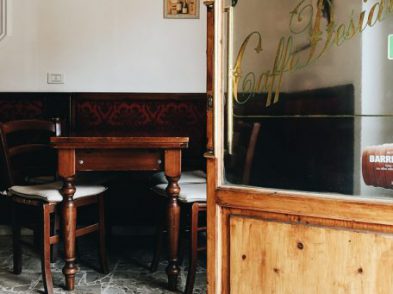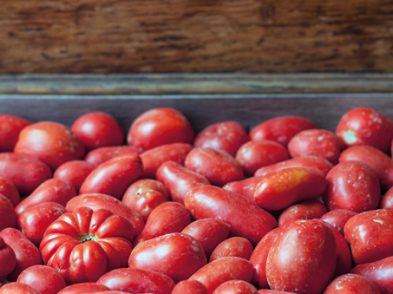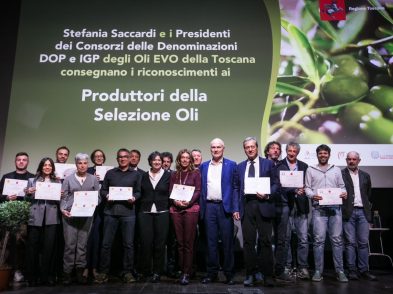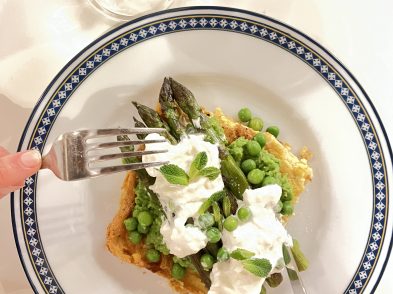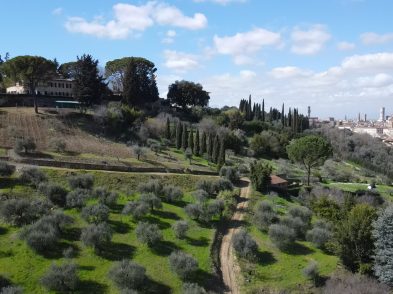The crêpe, that wafer-thin French cousin to the plump and fluffy American pancake, may actually have its origins in Florence. Completely transformed in a Florentine kitchen, Crespelle alla Fiorentina, Florentine style crêpes, are made with the same recipe and technique as French crêpes, but with a couple of important differences. They’re not eaten sweet, as the French usually do, but are stuffed with a ricotta and spinach filling, folded or rolled, then covered in generous amounts of besciamella (béchamel) sauce, a few spoonfuls of tomato puree, grated Pecorino cheese, then baked in the oven until golden brown.
In a way, crespelle are treated much like fresh pasta, somewhere between ravioli, cannelloni and lasagne. But unlike fresh pasta, which has thousands of different guises, this singular, beloved Florentine dish is always prepared this way.
Crespelle alla Fiorentina is an ancient dish that has its origins in the Florentine countryside. Affectionately called pezzole della nonna, ‘grandma’s handkerchiefs,’ because of their folded form, the earliest crespelle were no more than wafer-thin omelettes, filled with ricotta and seasonal vegetables and doused in the unappetizingly named salsa colla-literally ‘glue sauce,’ or white sauce, which later became known by the more elegant French name, béchamel sauce, after being perfected in the kitchens of Maria de’ Medici. The omelettes evolved with the wealthier addition of milk and flour to form the crespelle that we know today.
As with other modern dishes from sorbet to French onion soup (see TF 141 and 143), we can probably thank the Florentine Catherine de’ Medici, with her decisive taste for her own native food, for not only introducing crespelle to France when she married the future French King, Henry II, in 1533, but also her favourite vegetable: spinach. Legend has it that she loved spinach so much that she insisted it be included in every meal. The dark leafy vegetable was already well known in Florence in the Middle Ages and by Catherine’s time, it grew in gardens all around the city. The trusted Tuscan chefs she brought with her to Paris diligently created her beloved spinach dishes as instructed, and since then any dish with spinach in it became known to the French as ‘Florentine style.’
This explains why one of my favourite brunch dishes, eggs Florentine, a version of eggs Benedict with poached eggs sitting on a bed of spinach and drizzled with Hollandaise sauce on an English muffin, carries the name of the Renaissance city yet could not be less Florentine. And before you ask, the very French quiche Florentine has nothing to do with Florence either.
Instead, here is a recipe for the very Florentine crespelle. Don’t be put off by the list of ingredients and steps, it’s very easy to make and quicker than it looks!
RECIPE: Crespelle alla Fiorentina
Serves four
For the batter:
150 gr of flour
300 ml milk
40 gr of butter, melted
2 eggs
Pinch of salt
For the filling:
1 egg
250 gr of ricotta
400 gr of blanched spinach
For the béchamel sauce:
500 ml milk
50 gr of butter
50 gr of flour
Salt and pepper
To finish:
3 or 4 heaped tablespoons of tomato puree (passata)
Grated pecorino (or parmesan) cheese
Olive oil for greasing
Method:
Preheat the oven to 180°C.
For the crespelle, sift the flour into a mixing bowl and add the eggs, mixing well with a whisk or mixer, then the milk and finally the melted butter, incorporating gently. Season with a pinch of salt. The mixture should be fluid (it should run off a spoon like oil) and without lumps. If it is too dense, you can add a little water or some more milk; this will depend on the size of your eggs. Set aside; ideally the batter should rest for about 30 minutes before using.
Heat a non-stick, lightly greased pan to medium heat and pour a ¼ cup or ladle-full of the crespelle batter into the centre of the pan, swirling to cover. When the top begins to look dry, gently flip with a spatula and allow to cook for 10 seconds or so more. They don’t need to brown; they should remain soft. Set aside until all the crespelle are done (this mixture should make eight crespelle).
For the béchamel, add the butter to a saucepan over low heat and when just melted, add the flour and mix until smooth. Carefully cook for a couple of minutes, stirring constantly. Slowly whisk in the milk until very smooth and bring to a boil, whisking continuously. Cook for 10 minutes or until thickened (the sauce should coat the back of a spoon). Remove from heat and season with salt, pepper and if desired, a little nutmeg. Set aside.
For the ricotta filling, take the freshly blanched, drained and squeezed spinach (cooked quickly in boiling water, then rinsed in cold water to stop the cooking process), chop finely and place in a bowl with the ricotta, egg and grated cheese and mix to combine.
Place a heaped tablespoon of ricotta filling on a crespella, fold in half, then in quarters and place, slightly overlapping, in a greased oven proof dish (alternatively you can roll them up like a cigar). Spoon over the besciamella sauce and ‘stain’ the top with a few decorative splashes of tomato puree. Sprinkle over a handful of grated pecorino and place in the oven for 15 to 20 minutes or until golden brown. Serve immediately.


Read more from Emiko Davies’ cookbook Florentine: The True Cuisine of Florence, published by Hardie Grant Books. Order your copy of Florentine: The True Cuisine of Florence here.


